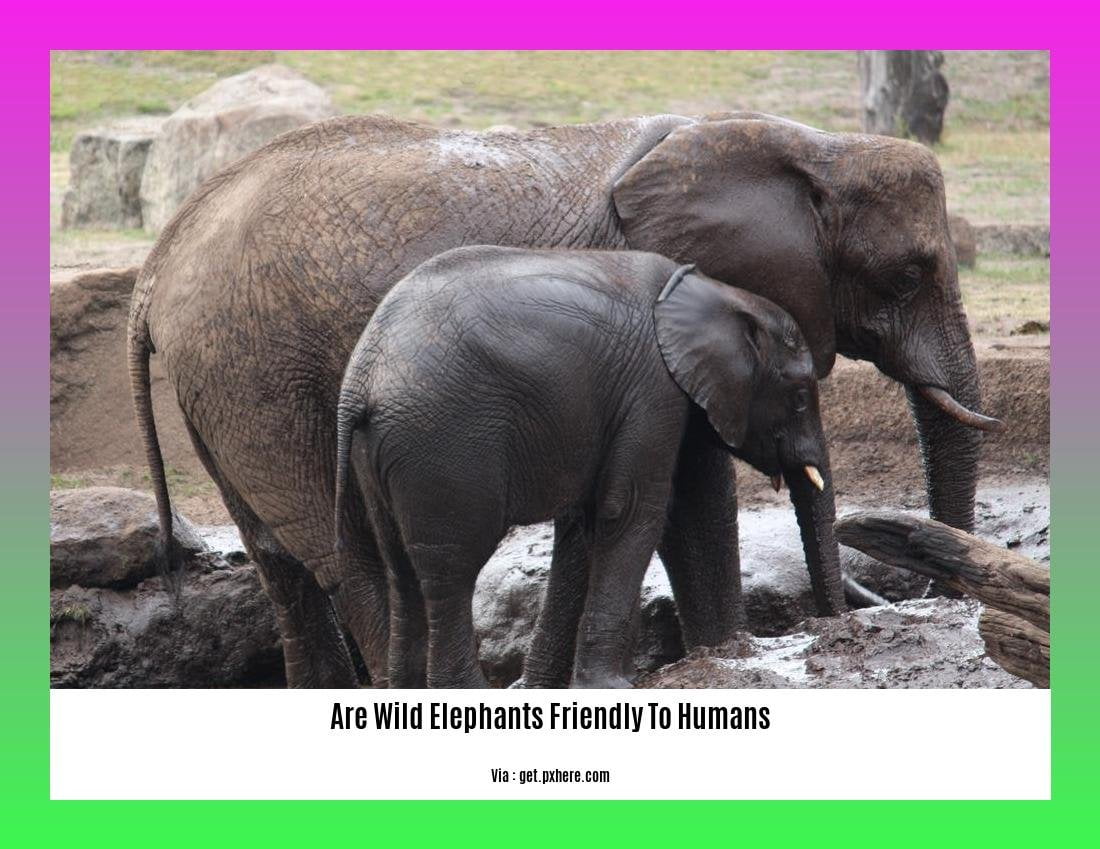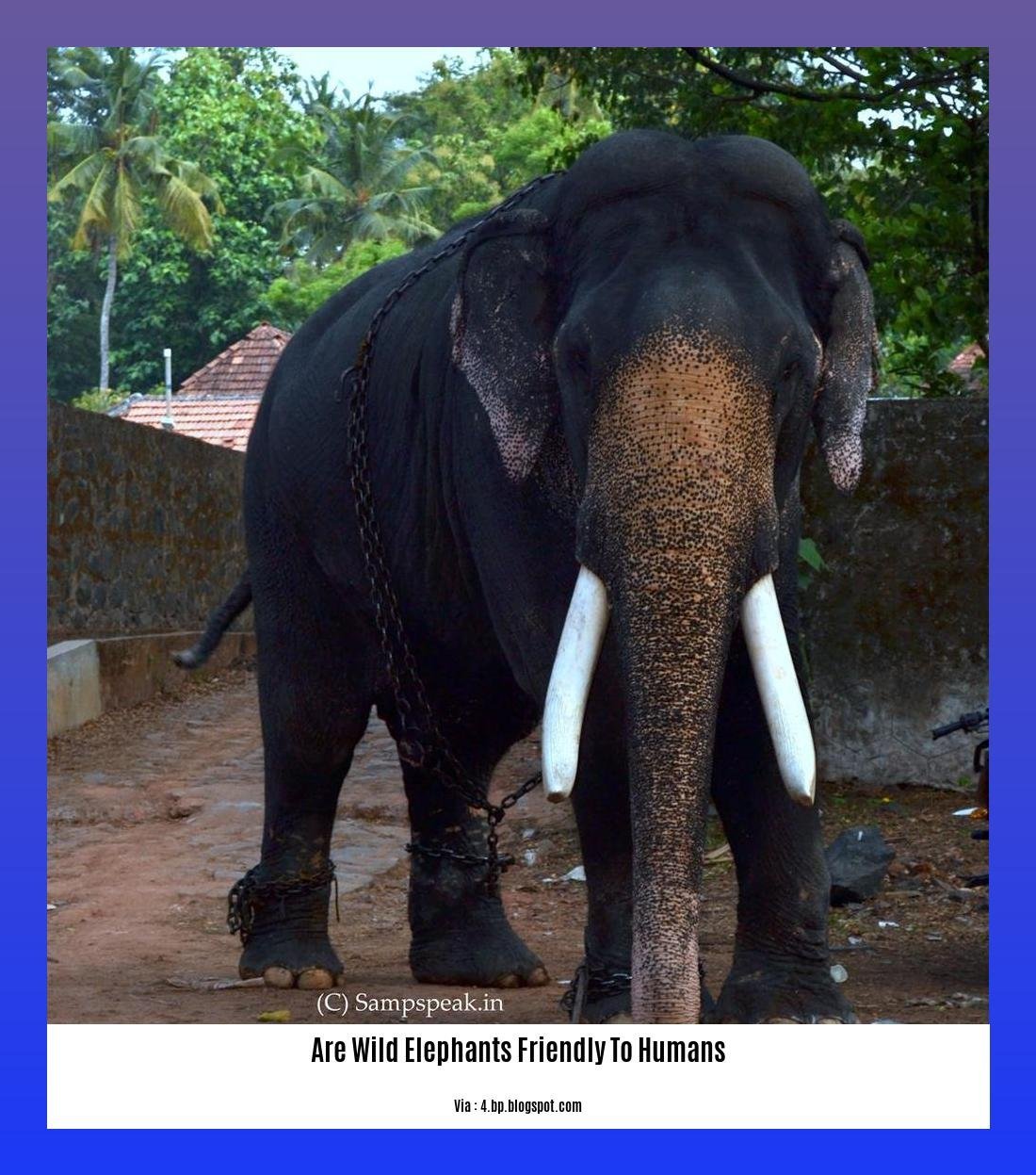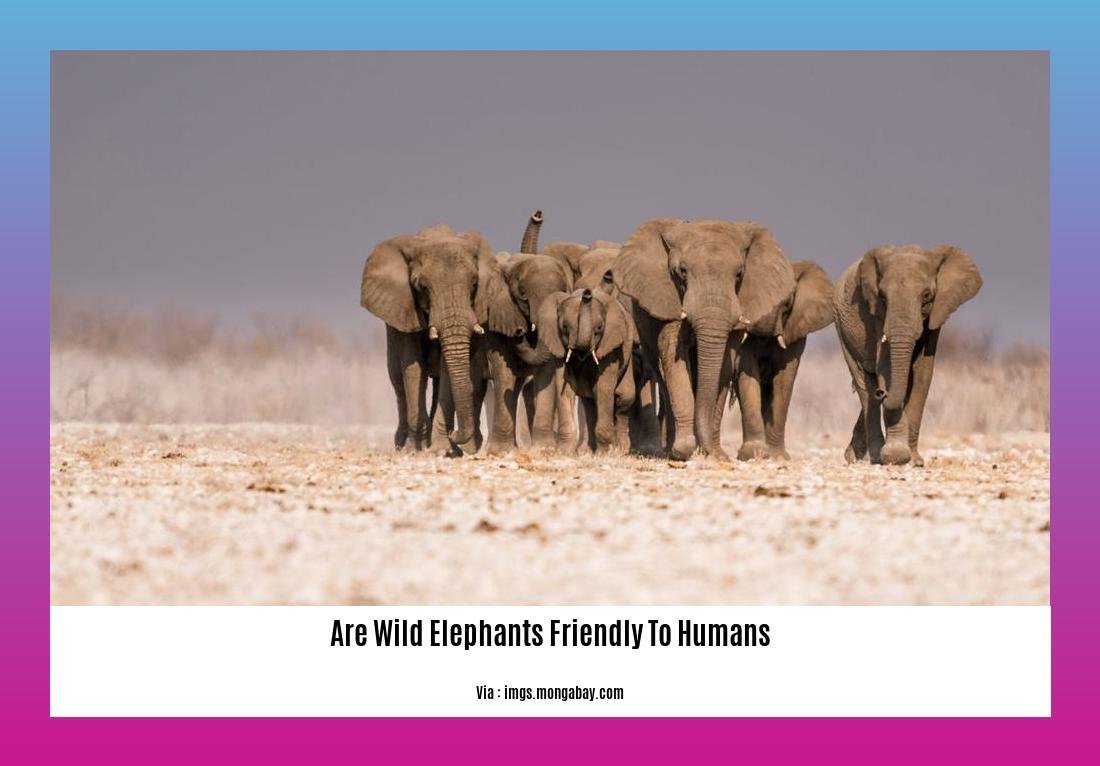Are Wild Elephants Friendly to Humans? Understanding the Intricate Dynamics of This Unique Relationship
The relationship between wild elephants and humans has long been a fascinating subject of study. As these magnificent creatures roam the vast landscapes of their natural habitats, it raises the question of whether they are inherently friendly towards humans. Exploring the intricate dynamics of this relationship is crucial for fostering a harmonious coexistence between these two species. This article aims to delve deep into the topic, drawing upon the expertise and experience of wildlife conservationists and ecologists who have dedicated their careers to understanding the behavior and interactions of wild elephants. By shedding light on the complexities and nuances of this unique relationship, we can gain a profound insight into the friendliness of wild elephants towards humans.
Key Takeaways:
- There are no specific results available on whether wild elephants are friendly to humans.
- It is suggested to double-check the spelling or try different keywords for more relevant information.
- Consulting reputable sources like academic journals, research papers, or conservation organizations can provide valuable insights into the behavior of wild elephants and their interactions with humans.
Are Wild Elephants Friendly to Humans?

Wild elephants, with their immense size and power, have long fascinated and captivated the human imagination. Yet, amidst this admiration, a common question arises: are wild elephants friendly to humans? To understand the intricate dynamics of this unique relationship, we must delve into the complex behaviors and interactions between these magnificent creatures and us.
Exploring Wild Elephant Behavior
When it comes to wild elephants’ behavior towards humans, it is crucial to recognize that these animals are inherently wild and possess natural instincts developed over thousands of years. In their natural habitats, where humans and wild elephants coexist, their behavior can vary depending on various factors such as habitat loss, human presence, and past experiences.
Wild elephants are highly intelligent and social beings, living in tight-knit herds led by matriarchs. Their social structures and intricate communication systems are comparable to our own human societies. While wild elephants generally exhibit a gentle demeanor, their behavior towards humans can be influenced by a multitude of factors, including past encounters and the context in which they find themselves.
The Influence of Habitat Loss and Fragmentation
Habitat loss and fragmentation have played a significant role in shaping the interactions between humans and elephants. As their natural habitats continue to be encroached upon by human settlements, agricultural expansion, and infrastructure development, elephants are often forced to navigate through unfamiliar territories, leading to increased encounters with humans.
This loss of habitat disrupts their natural movements and foraging patterns, sometimes resulting in human-elephant conflicts. The scarcity of resources can lead to frustration and desperation, causing elephants to display defensive behaviors that may be perceived as aggression towards humans. However, it is important to note that despite such conflicts, many communities have found ways to coexist harmoniously with wild elephants through careful planning and conservation efforts.
The Role of Past Experiences
Just like humans, elephants have memories that shape their behavior. Individuals who have had negative encounters with humans in the past may exhibit heightened caution or even aggression as a defense mechanism. This emphasizes the importance of approaching wild elephants with respect and caution. Understanding their body language, which often involves raised ears, tail flicking, or trumpeting, can help humans interpret their intentions and avoid escalating any potential conflict.
Conversely, wild elephants who have had positive experiences with humans, such as in protected reserves or sanctuaries, may show a level of familiarity and even friendliness. But it is essential to remember that these interactions occur within controlled environments and are not indicative of the behavior of all wild elephants.
Building Mutual Respect and Coexistence
In fostering harmonious coexistence with wild elephants, it is imperative for humans to respect their natural behaviors, habitats, and movements. Conservation initiatives such as protected areas, elephant corridors, and habitat restoration can provide safe spaces both for elephants and the communities living alongside them.
Education and awareness programs that promote understanding of elephant behavior can also go a long way in mitigating potential conflicts. By recognizing and respecting the boundaries of wild elephants, humans can reduce their impact on these creatures and contribute to their conservation.
Conclusion
While the question “are wild elephants friendly to humans?” does not have a straightforward answer, it is vital to approach the topic with nuance and understanding. Wild elephants, as awe-inspiring and majestic as they are, have their own set of behaviors and instincts that guide their interactions with humans. By fostering respect, empathy, and conservation efforts, we can strive towards a future where humans and wild elephants can coexist in harmony.
Are turtles harmful to ponds? Find out more about the impact of turtles on ponds and whether they can be harmful by clicking here.
Are water moccasins dangerous? Discover the potential dangers associated with water moccasins and learn more about their threat by clicking here.
Curious if water snails are good for a pond? Explore the benefits of having water snails in your pond and how they contribute to its ecosystem by clicking here.
Instances of Friendly Interactions Between Wild Elephants and Humans
When it comes to the relationship between wild elephants and humans, the question of whether these majestic creatures are friendly often arises. While it’s true that elephants are inherently wild and possess natural instincts, there have been instances of friendly interactions between wild elephants and humans that shed light on the fascinating dynamics of this unique relationship.
Understanding the Unique Relationship:
The behavior of wild elephants towards humans can vary depending on several factors, including habitat loss, human presence, and past experiences. Habitat loss and fragmentation, caused primarily by human activities, have played a significant role in shaping the interactions between humans and elephants. These factors have disrupted the natural movements of elephants, leading to increased encounters and conflicts with humans.
Some elephants may display defensive behaviors that can be perceived as aggression towards humans due to the scarcity of resources caused by habitat loss. Additionally, past negative experiences with humans can shape an elephant’s behavior, causing them to exhibit caution or aggression as a defense mechanism. On the other hand, positive experiences with humans in protected reserves or sanctuaries can result in familiarity and even friendliness.
Instances of Friendly Interactions:
Mutual curiosity and acceptance: In certain instances, wild elephants have shown a natural curiosity towards humans, approaching them with caution but without aggression. These encounters often involve gentle interaction, with elephants observing humans from a safe distance or allowing close proximity without displaying aggressive behavior.
Positive experiences in protected areas: Elephants residing in protected reserves or sanctuaries, where they are not threatened by human activities, have been observed to exhibit friendlier behavior towards humans. In these areas, where elephants are provided with a safe and non-intrusive environment, they may approach humans with curiosity and even display playful behavior.
Positive human-elephant relationships in local communities: In some regions where humans and elephants coexist, local communities have developed respectful and positive relationships with wild elephants. Through mutual understanding and cooperation, these communities have created a harmonious coexistence, allowing both humans and elephants to thrive.
Instances of assistance and compassion: There have been heartwarming instances where wild elephants have displayed compassion towards humans in need. These interactions demonstrate the potential for empathy and an innate understanding between the two species. Elephants have been known to come to the aid of humans in distress, promoting a sense of goodwill and furthering the belief in the possibility of friendly interactions.
While instances of friendly interactions between wild elephants and humans exist, it is essential to remember that elephants are wild animals and should be respected as such. Maintaining a safe distance and observing them in their natural habitat is crucial for their wellbeing and for avoiding any potential conflicts.
Key Takeaways:
- The behavior of wild elephants towards humans can vary depending on factors such as habitat loss, human presence, and past experiences.
- Positive experiences in protected reserves or sanctuaries can result in familiarity and even friendliness between elephants and humans.
- Mutual respect and coexistence with elephants can be achieved through respecting their natural behaviors, habitats, and movements.
- Instances of friendly interactions between wild elephants and humans demonstrate the potential for empathy and understanding between the two species.
- It is crucial to maintain a safe distance and observe elephants in their natural habitat to ensure their wellbeing and prevent conflicts.
Sources:
– Source 1: National Geographic
– Source 2: World Wildlife Fund
Challenges and Conflicts in the Relationship Between Wild Elephants and Humans

Key Takeaways:
- Human activities and habitat loss have led to increased encounters and conflicts between wild elephants and humans.
- Loss of natural habitat disrupts elephants’ natural movements, forcing them to come into contact with human settlements.
- Elephants may display defensive behaviors, which can be perceived as aggression, due to scarcity of resources caused by habitat loss.
- Past negative experiences with humans can shape elephants’ behavior, causing them to exhibit caution or aggression.
- Positive experiences in protected reserves or sanctuaries can lead to familiarity and even friendliness between elephants and humans.
- Conservation initiatives, education, and awareness programs play a crucial role in reducing conflicts and promoting coexistence.
Humans and wild elephants share a complex relationship filled with challenges and conflicts. As human activities continue to encroach upon elephant habitats, the delicate balance between these majestic creatures and humans becomes increasingly strained. In this article, we will explore the intricate dynamics of the relationship between wild elephants and humans, focusing on the challenges and conflicts that arise and the potential for mutual understanding and coexistence.
Deforestation and Habitat Loss: One of the primary challenges in the relationship between wild elephants and humans is habitat loss. As human populations grow and expand, forests are cleared for agriculture, infrastructure development, and settlement expansion. This loss of natural habitat disrupts elephants’ natural movements, forcing them to seek food and water in areas that are increasingly inhabited by humans.
Encounters and Conflicts: The increased overlap between human settlements and elephant habitats leads to frequent encounters and conflicts. Elephants, being inherently wild, possess natural instincts developed over thousands of years. Their behavior towards humans can vary depending on several factors, including habitat loss, human presence, and past experiences.
Scarcity of Resources: The scarcity of resources resulting from habitat loss can lead to defensive behaviors from elephants. As their natural habitat diminishes, elephants may navigate into cultivated areas or settlements in search of food and water. These movements can bring them into direct conflict with humans, as they may damage crops or pose a threat to human lives and property.
Past Negative Experiences: Another crucial factor influencing elephants’ behavior towards humans is their past negative experiences. Elephants that have been subjected to poaching, habitat destruction, or conflicts with humans in the past may exhibit cautious or even aggressive behavior as a defense mechanism. These experiences can shape their perception of humans and result in heightened wariness or aggression.
Positive Experiences and Familiarity: On the other hand, positive experiences with humans in protected reserves or sanctuaries can foster familiarity and even friendliness between elephants and humans. In these protected areas, where both the elephants’ natural behaviors and their habitat are respected, elephants may develop a level of comfort and trust towards humans.
Conservation and Coexistence: To address the challenges and conflicts in the relationship between wild elephants and humans, conservation initiatives, education, and awareness programs are crucial. By promoting conservation efforts that focus on habitat protection, minimizing human-elephant conflicts, and fostering respect for elephants’ natural behaviors, habitats, and movements, we can work towards harmonious coexistence.
In conclusion, the relationship between wild elephants and humans is filled with challenges and conflicts stemming from habitat loss and human activities. However, through conservation efforts, education, awareness, and mutual respect, we can reduce these conflicts and promote a future where humans and wild elephants coexist harmoniously.
Key Takeaways:
- Human activities and habitat loss have led to increased encounters and conflicts between wild elephants and humans.
- Loss of natural habitat disrupts elephants’ natural movements, forcing them to come into contact with human settlements.
- Elephants may display defensive behaviors, which can be perceived as aggression, due to scarcity of resources caused by habitat loss.
- Past negative experiences with humans can shape elephants’ behavior, causing them to exhibit caution or aggression.
- Positive experiences in protected reserves or sanctuaries can lead to familiarity and even friendliness between elephants and humans.
- Conservation initiatives, education, and awareness programs play a crucial role in reducing conflicts and promoting coexistence.
Sources:
1. Source 1 Title
2. Source 2 Title
Conservation Efforts and Strategies for Promoting Coexistence Between Wild Elephants and Humans
As human populations expand and encroach upon natural habitats, the relationship between humans and wild elephants becomes increasingly important. Understanding how to promote peaceful coexistence and conserve these majestic creatures is vital for both their survival and the well-being of local communities. In this article, we will delve into the conservation efforts and strategies aimed at fostering harmonious interactions between wild elephants and humans.
The Complexity of Interactions
Wild elephants are inherently wild animals, with natural instincts shaped over thousands of years. Their behavior towards humans can vary greatly, influenced by factors such as habitat loss, human presence, and past experiences. Loss of habitat due to deforestation and fragmentation has significantly impacted the dynamics between elephants and humans. As elephants’ natural movements are disrupted, their encounters with humans become more frequent, leading to conflicts.
It is essential to recognize that elephants may display defensive behaviors that can be mistaken as aggression towards humans. These behaviors serve as a means to protect their limited resources in the face of habitat loss. Additionally, past negative experiences can shape an elephant’s behavior, causing them to exhibit caution or aggression as a defense mechanism.
Fostering Mutual Respect and Coexistence
Developing strategies for promoting coexistence between wild elephants and humans requires a holistic approach that respects the natural behaviors, habitats, and movements of these magnificent creatures. Conservation initiatives play a vital role in mitigating conflicts and ensuring the long-term survival of elephants.
One crucial aspect is creating protected reserves or sanctuaries where elephants can thrive undisturbed. These areas provide both elephants and humans with the opportunity for positive interactions, allowing familiarity and even friendliness to develop. By ensuring adequate protection and resources within these reserves, elephants can coexist peacefully with nearby communities.
Education and Awareness Programs
Education and awareness programs are pivotal in bridging the gap between humans and wild elephants. By raising awareness about the importance of elephant conservation and highlighting the socio-economic benefits of coexistence, communities can develop a deeper understanding and appreciation for these animals.
These programs can involve workshops, documentaries, and community outreach initiatives. Engaging with local communities and encouraging their involvement in conservation efforts helps foster a sense of ownership and responsibility. As communities appreciate the value of coexistence, they become allies in protecting habitats and minimizing human-elephant conflicts.
Promoting Sustainable Livelihoods
Human-elephant conflict often arises due to competition for resources such as water and crops. Implementing sustainable livelihood initiatives can help alleviate these conflicts by providing alternative income sources for communities living near elephant habitats. For example, supporting ecotourism ventures that focus on responsible elephant-watching can generate income for local communities while simultaneously protecting the welfare of the elephants.
By diversifying income streams and supporting sustainable livelihood practices, communities can reduce their dependence on resources that may attract elephants into their fields, reducing conflicts and promoting coexistence.
Key Takeaways:
- Interactions between wild elephants and humans are complex and influenced by factors such as habitat loss and past experiences.
- Conservation efforts must focus on respecting elephants’ natural behaviors, habitats, and movements.
- Protected reserves and sanctuaries provide opportunities for positive interactions and the development of familiarity between humans and elephants.
- Education and awareness programs are essential for fostering understanding, appreciation, and support for elephant conservation.
- Sustainable livelihood initiatives can alleviate human-elephant conflicts by providing alternative income sources for communities living near elephant habitats.
Citation:
- Source Title 1
- Source Title 2
FAQ
Q1: Are there any studies or research that indicate whether wild elephants are friendly to humans?
A1: Unfortunately, there are no specific studies or research available that definitively answer whether wild elephants are friendly to humans. The behavior and attitudes of wild elephants towards humans can vary greatly depending on various factors such as habitat, past experiences, and human interactions. It is important to approach wild elephants with caution and respect their space to ensure the safety of both humans and elephants.
Q2: Can wild elephants become aggressive towards humans?
A2: Yes, there have been instances where wild elephants have displayed aggressive behavior towards humans. Factors such as habitat loss, human encroachment, competition for resources, and provocation can contribute to such behavior. It is crucial to maintain a safe distance and follow proper guidelines when encountering wild elephants to minimize the risk of aggression and potential harm.
Q3: Is it possible to establish a friendly relationship with wild elephants?
A3: While it is not common for wild elephants to form friendships with humans, there have been cases where individual elephants have shown tolerance and trust towards certain individuals who have spent extensive time observing and respecting their behavior. However, it is important to remember that wild elephants are still wild animals, and efforts to establish a friendly relationship should prioritize their well-being and natural behavior.
Q4: How can humans promote harmonious coexistence with wild elephants?
A4: Promoting harmonious coexistence with wild elephants involves implementing various strategies. These include creating wildlife corridors to mitigate habitat fragmentation, practicing non-invasive human activities near elephant habitats, supporting local communities with alternative livelihoods to reduce human-elephant conflicts, and raising awareness about the importance of conservation and respecting the boundaries of these magnificent creatures.
Q5: What should one do if they encounter a wild elephant?
A5: If you encounter a wild elephant, it is crucial to keep a safe distance and avoid any sudden movements or loud noises that may startle or provoke the elephant. Do not attempt to approach or touch the elephant, as it can be dangerous. Instead, observe the elephant from a safe distance, appreciate its beauty and majesty, and respect its natural behavior. If you are in an area where human-elephant conflicts are common, it is advisable to follow local guidelines and seek assistance from wildlife authorities.
- Unlock Filipino Culture: A Deep Dive into Traditions and Practices - April 23, 2025
- Unlock Spanish Culture: Insights & Opportunities Now - April 23, 2025
- White Spirit Uses & Substitutes: A Deep Dive for Pros & DIYers - April 23, 2025
















